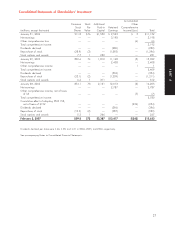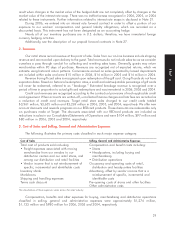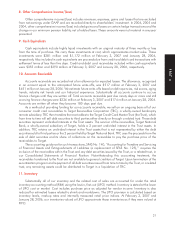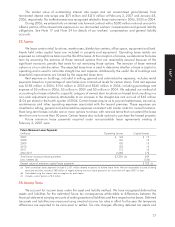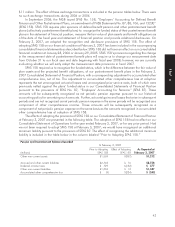Target 2006 Annual Report Download - page 55
Download and view the complete annual report
Please find page 55 of the 2006 Target annual report below. You can navigate through the pages in the report by either clicking on the pages listed below, or by using the keyword search tool below to find specific information within the annual report.
The market value of outstanding interest rate swaps and net unamortized gains/(losses) from
terminated interest rate swaps was $(7) million and $(21) million at February 3, 2007 and January 28,
2006, respectively. No ineffectiveness was recognized related to these instruments in 2006, 2005 or 2004.
During 2006, we entered into an interest rate forward contract with a $300 million notional amount to
offset a portion of the interest rate exposure on our discounted workers’ compensation and general liability
obligations. See Note 17 and Note 24 for details of our workers’ compensation and general liability
accruals.
22. Leases
We lease certain retail locations, warehouses, distribution centers, office space, equipment and land.
Assets held under capital lease are included in property and equipment. Operating lease rentals are
expensed on a straight-line basis over the life of the lease. At the inception of a lease, we determine the lease
term by assuming the exercise of those renewal options that are reasonably assured because of the
significant economic penalty that exists for not exercising those options. The exercise of lease renewal
options is at our sole discretion. The expected lease term is used to determine whether a lease is capital or
operating and is used to calculate straight-line rent expense. Additionally, the useful life of buildings and
leasehold improvements are limited by the expected lease term.
Rent expense on buildings, included in selling, general and administrative expenses, includes rental
payments based on a percentage of retail sales over contractual levels for certain stores. Total rent expense
was $158 million in 2006, $154 million in 2005 and $240 million in 2004, including percentage rent
expense of $5 million in 2006, $5 million in 2005 and $3 million in 2004. We adjusted our method of
accounting for leases related to a specific category of owned store locations on leased land, resulting in a
non-cash adjustment primarily attributable to an increase in the straight-line rent accrual of $65 million
($.04 per share) in the fourth quarter of 2004. Certain leases require us to pay real estate taxes, insurance,
maintenance and other operating expenses associated with the leased premises. These expenses are
classified in selling, general and administrative expenses consistent with similar costs for owned locations.
Most long-term leases include one or more options to renew, with renewal terms that can extend the lease
term from one to more than 50 years. Certain leases also include options to purchase the leased property.
Future minimum lease payments required under noncancelable lease agreements existing at
February 3, 2007 were:
Future Minimum Lease Payments
(millions) Operating Leases Capital Leases
2007 $ 142 $ 15
2008 136 15
2009 130 15
2010 122 16
2011 113 16
After 2011 2,682 172
Total future minimum lease payments $3,325 (a) 249
Less: Interest (b) (126)
Present value of minimum capital lease payments $ 123 (c)
(a) Total contractual lease payments include $1,631 million related to options to extend lease terms that are reasonably assured of being
exercised and also includes $188 million of legally binding minimum lease payments for stores that will open 2007 or later.
(b) Calculated using the interest rate at inception for each lease.
(c) Includes current portion of $3 million.
23. Income Taxes
We account for income taxes under the asset and liability method. We have recognized deferred tax
assets and liabilities for the estimated future tax consequences attributable to differences between the
financial statement carrying amounts of existing assets and liabilities and their respective tax bases. Deferred
tax assets and liabilities are measured using enacted income tax rates in effect for the year the temporary
differences are expected to be recovered or settled. Tax rate changes affecting deferred tax assets and
37
PART II


